
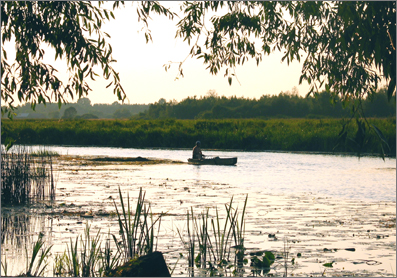
Welcome to the Mońki county, a region with the biggest in Central Europe area of marshes, where the air is clean, the forests and nature unique. Where thrifty and kind people cultivate folk traditions and local customs and at the same time attach importance to economic development and modern lifestyle. We offer a possibility to explore the cultural heritage and history of towns and villages of our county. The region is admired for its original form and exceptional structure not only by biologists and researchers, but also by tourists who want to enjoy the sight of the beaver, elk or ruff living in the wild.
The Mońki county looks forward to seeing everyone who would like to find a peaceful place for relax as well as a prosperous future for economic enterprise.
The Mońki county
The Mońki county, which comprises towns and communes of Mońki, Knyszyn, Goniądz as well as communes of Jasionówka, Jaświły, Krypno and Trzcianne, is situated at the confluence of the Biebrza and the Narew Rivers in the central part of the Podlaskie Province. It covers an area of 138,259 ha, which is 7% of the province. 45,000 people (4% of the population of Podlasie) live here. The county has plenty of natural and historical values and it also offers great possibilities for the development of agriculture and tourism.
"Not many parts of our country can compare with the region between the Narew and the Bug. It is beautiful here at any time of year. An eye sensitive to the beauty of landscape can find delightful things here even in autumn fogs and winter silence. However spring is the most beautiful. Irregular courses of the rivers flowing in post-glacial marshy valleys and a thick cover of snow and ice make the region where the Biebrza flows into the Narew change into immense floodwaters. (...)"
Włodzimierz Puchalski (1909 - 1979) outstanding Polish naturalist, photographer and precursor of the Polish nature film
The county of three parks
The Mońki county has exceptional ecological and landscape values. It is surrounded by valuable natural objects: in the west considerable part of the county is taken by the Biebrza National Park, in the east there are edges of the Landscape Park of the Knyszyńska Forest, whereas the south edges of the county belong to the Protected Landscape Area of the 'Narew Valley' and come close to the protective buffer zone of the Narwiański National Park.
The Biebrza National Park
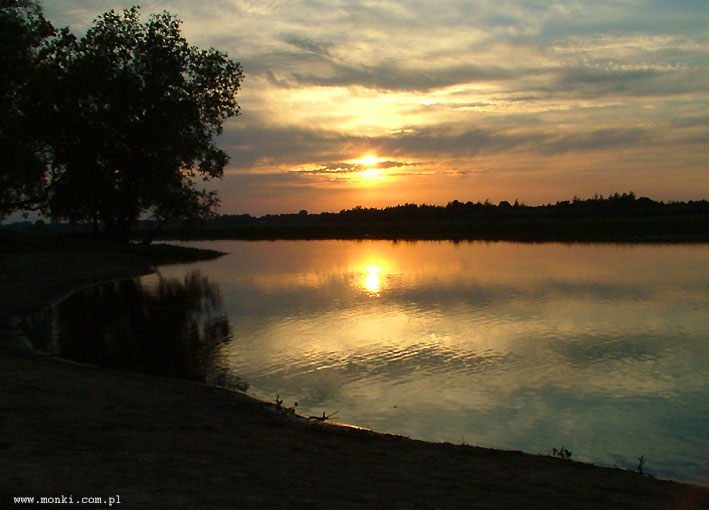
The most valuable natural object of the county is the Biebrza National Park - unique on the European scale. It is the only natural marsh area in this part of the continent. It preserved its natural condition thanks to naturalists and environmentalists whose efforts stopped damaging land reclamation. Consequently, first a landscape park and then, in 1993, Poland's biggest national park was established.
Such a big and unique natural complex of peatland located on the picturesquely meandering river has not only exceptional landscape values which inspire artists, photographers and tourists seeking adventures. Most of all it is a refuge for many rare species of fauna and flora. For centuries it has been a habitat of otters, badgers, foxes, wolves, weasels, ermines and many more. However, the Biebrza Marshes are most of all the kingdom of birds: more than 200 species live here. The rarest of them are white-tailed eagle, spotted eagle, black stork, aquatic warbler and the symbol of the Biebrza National Park - ruff.
The meandering Biebrza, its tributaries and ox-bow lakes are a habitat of a few dozen species of fish and other water animals. The exceptionality of the area is also enhanced by the abundance of its flora. It is here, on the Biebrza river, that one can see rare and dying out species of plants, such as shrubby birch, downy willow, whortleberry willow, marsh saxifrage and moor-king.
We owe it to the Biebrza Marshes that some important species of plants and animals have been saved. At the begining of the twentieth century two strict nature reserves were set up here, namely Czerwone Bagno (the Red Mire) and Grzędy. When during the World War II the elk was almost entirely killed in Poland, it was here, in the area of the Red Mire, that a few examples of the species survived. The introduction of these animals was thus possible. After the war the descendants of the Biebrza elks wandered to distant parts of Poland and also abroad. Nowadays, with a bit of luck and patience, a tourist or a naturalist can meet one of the elks living on the Biebrza.
Another thing we owe to the Biebrza Marshes is the recreation of beavers which used to be entirely extinct in our country. In 1949 eighteen examples of the species were brought to the canals surrounding the Osowiec Forts from Bielarussia. The local rivers and canals turned to be a paradise for beavers.
The pristine character and inaccessibility of the area for many years made the Biebrza Marshes interesting only to scientists and connoisseurs. Thanks to that the area avoided noisy mass tourism which usually damages the environment. Nowadays - thanks to the establishment of the Biebrza National Park and the development of appropriate infrastructure - it has become friendlier to an amateur tourist. Today, if someone wishes to experience unique Biebrza nature, it is not necessary to wander across dangerous marshes and floodwaters in wellington boots. Special natural and historical trails with footbridges and viewing towers make it possible to visit interesting parts of the park without getting wet. A visitor can also take advantage of the local educational centre located in the Osowiec Forts where specialists and licenced guides offer help and are eager to share their knowledge.
Royal Knyszyńska Forest
Great ecological importance and landscape values attract wide numbers of tourist and scientists to the Professor Witold Sławiński Landscape Park of the Knyszyńska Forest. It was established in 1988 in order to preserve the existing forest areas and river valleys in the form unchanged by civilization. For centuries they have been famous as a land inhabited by wild animals which were hunted by, among others, king Zygmunt August. Today, like in the times of the king, we can meet in the park deer, elks, roe-deer, wild boars and - since 1975 - bisons brought here from Białowieża. The Knyszyńska Forest is also a refuge for 139 species of breeding birds, such as black stork, three-toed woodpecker and crane. There are also numerous natural monuments here - aged trees and erratic blocks. The characteristic elements of the forest are little wooden shrines hanging on so called 'sacred pines'. Their tradition comes from the times of the January Uprising when they served as contact boxes for insurgents. On the edges of the Knyszyńska Forest there is another thing worth recommending - nature reserve 'Big Forest' which was founded because of its unique natural values.
On the Narew river
The south edges of the Mońki county belong to the Protected Landscape Area of the "Narew Valley" and almost touch the protective buffer zone of the Narwiański National Park. It is one of the youngest national parks in Poland and was set up in 1996 in order to preserve the last unchanged fragment of the Narew valley in its natural state - with its abundance of fauna, flora and its landscape values.
Włodzimierz Puchalski (1909-1979) was a great admirer of Biebrza and Narew nature. This outstanding Polish photographer and pioneer of Polish nature film "discovered" in 1948 a village of Morusy (commune of Krypno) lying on the Narew. Since then, charmed by the beauty of the area, he visited it every year and later bought an XVIII-century thatched cottage there. It became, as he himself used to say, a base for his 'bloodless hunting escapades' during which a camera or a camcorder replaced firearms. After his sudden death during an expedition to Antarctica, his cottage in Morusy full of souvenirs and equipment was taken under care and to this day, preserving its extraordinary climate from distant years, it functions as a unique private mini-museum dedicated to its former owner.
In the introduction to his album 'On the floodwaters of the Biebrza and Narew', Włodzimierz Puchalski wrote:
"The landscape here changes from day to day and where only yesterday blue and willow green surfaces of waters shone, today meadows are turning green and they will soon explode with the gold of blooming cowslips."
A WALK THROUGH THE COUNTY Located in the centre of the county, Mońki is its capital and biggest town. Its history is connected to the railway station built towards the end of the XIX century, around which a settlement started to develop. In the 20s of the next century a big neobaroque church was built (Church under the invocation of Our Lady of Częstochowa and St. Kazimierz). It was designed by a famous Warsaw architect, Stefan Shyller. There are two important dates in the history of Mońki: the year 1954 when it became the seat of county authorities and the year 1965 when it received city rights. The Osowiec Forts The Osowiec Forts is undoubtfully the most valuable monument in the Mońki county. It is located in the Biebrza National Park.
From the very beginning the Osowiec Forts was of a significant strategic importance, since it closed the only existing passage across vast marshes and flood waters of the Biebrza. Despite the fact that it consisted of only four forts, it was one of the most powerful fortresses, thanks to a well developed system of foregrounds and flood-gates. During the World War I German troops attempted to conquer it three times and failed; the Russian crew was evacuated in August, 1915, due to overall bad situation on the front. Krypno - spiritual heart of the region Krypno, situated 22 km away from Mońki, has been a well-known centre of the Virgin Mary's cult. In the Church of the Holy Virgin's Birth, dating from the second half of 19th century, there is the famous picture of Comforting Holy Virgin, painted on lime wood, whose cult dates back to 16th century. It is one of the oldest copies of the picture from Santa Maria Maggiore Basilica in Rome, probably brought by hetman Jan Zamoyski to his chapel in a nearby Knyszyn. In 1985 the picture was formally crowned with pope's diadems, thus increasing its popularity. The sanctuary has been a traditional place for pilgrimages from the archdiocese.
Knyszyn - the town of king Zygmunt In the 16th century it was a king's town, a favourite place of Zygmunt August, who not only loved hunting in these forests, but also stayed here to rule the Republic of Two Nations. Knyszyn was the place where the last ruler of the Jagiellonian dynasty passed away on July 7, 1572. Goniądz The first settlement of the Mazovian princes was founded here as early as in the Middle Ages. In 1547 Goniądz, then a significant river port and trade centre, received town's rights. We can still see the remains of the 16th century town-planning system as well as a monumental Church of St. Agnes from 1920's. Agrotourism - tradition and ecology Life of people native to this region has always been closely connected with cycles of nature, and the long-preserved methods of soil cultivating haven't disturbed the ecological balance. This is the reason why these valuable natural surroundings haven't been destroyed or devastated. Its rich history, influence of Polish, Lithuanian, Russian, Prussian and Jewish cultures, as well as ardent religiousness have formed its cultural heritage. Although the technical development has caused considerable changes in the lifestyle of its inhabitants, there can still be seen traces of old tradition, culture and even traditional ways of farming. There are still farmers using peat from the Biebrza bogs for heating purposes, fishermen sailing in traditional boats and farmers scything their grass.
The traditional hospitality of the region's inhabitants makes its agrotourist farms (22) especially attractive for those, who want to find cheap and interesting places to spend their holidays.
Economy
The Mońki county, with its 45 thousand inhabitants, is a typically agricultural region. Favourable climatic and soil conditions as well as unpolluted environment favour cereals and potato growing. Livestock farms are mainly occupied with pig and cattle production. Small food processing companies develop their production.
There are three main towns in the region, of which Mońki, with its 11 thousand inhabitants, is the biggest. It is located at the crossing of two important roads in the podlaskie province: the railroad Białystok - Ełk and interprovince road nr 65. It is situated north of Białystok (44 km) and south of Grajewo (36 km) and Ełk (56 km). The nearby towns (Knyszyn and Goniądz) are also close to the main routes.
The communication conditions provide easy transport of goods to markets in the province as well as across the eastern border. The communes are equipped with modern communication technology, which provides easy information exchange. An additional advantage is that Monki is situated near the capital of the podlaskie province - Bialystok.
Worth seeing - monuments of the Mońki county:
The Town and Commune of Mońki:
Mońki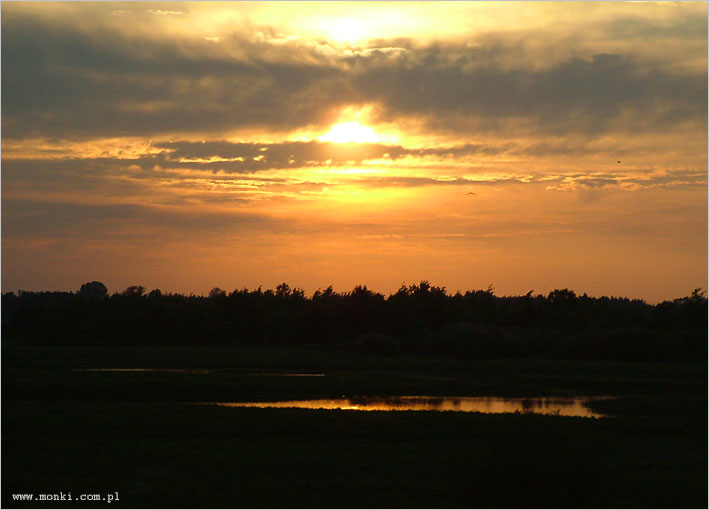
Within a few decades Mońki changed into a fast developing town with public utilities, cultural and educational institutions.
Nowadays Mońki is a home for 11 thousand people and it is an important economic and cultural centre. In summertime numerous galas and social events are organized. Thanks to its tourist infrastructure, the town is a convenient base for those interested in the exceptional natural values and rich history of the villages and small towns of the Mońki county.
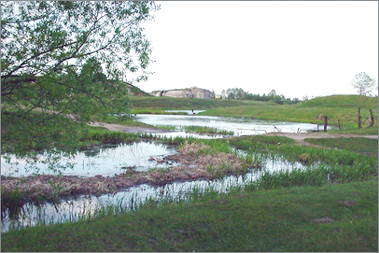
The strategic importance of the Forts wasn't neglected during the World War II, when both Soviet as well as German troops based their defence in that region on the Biebrza marshes.
Workshops of painting are organised in Osowiec Forts every year. In 1998 a museum was opened in Fort I. The members of The Society of Osowiec Forts willingly take visitors round the Forts, its dark, gloomy and mysterious shelters, vaults and the 'death tunnel', where the ghost of a tsar's officer is said to be seen. The guides will tell visitors about the history of the place as well as its legends and ghosts.
This place is not only interesting for tourists. For years there have lived numerous species of animals, white-tailed eagle, elks and deers, fish, beavers and grass snakes in the moats. There is also one of the biggest winter quarters of bats in Poland.
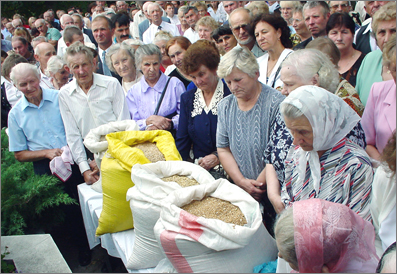
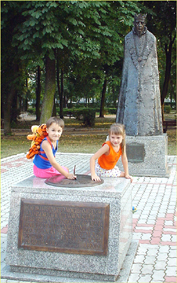
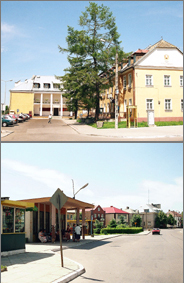
The time of king Zygmunt August was the time of greatest prosperity of Knyszyn, which was granted city rights in 1568. Then the Town Hall, baths and the building of weight were built and the streets were paved. Today we can see the remains of the 16th century town-planning system as well as the late Gothic Church under the invocation of St. John the Apostle and St. John the Evangelist. The monumental cemetries - Roman Catholic, Protestant, Orthodox and Jewish - remind of the town's multi-cultural past.
>At present Knyszyn has three thousand inhabitants. There are schools, a healthcare centre and a culture centre, where an amateur theatre, music and art groups meet.
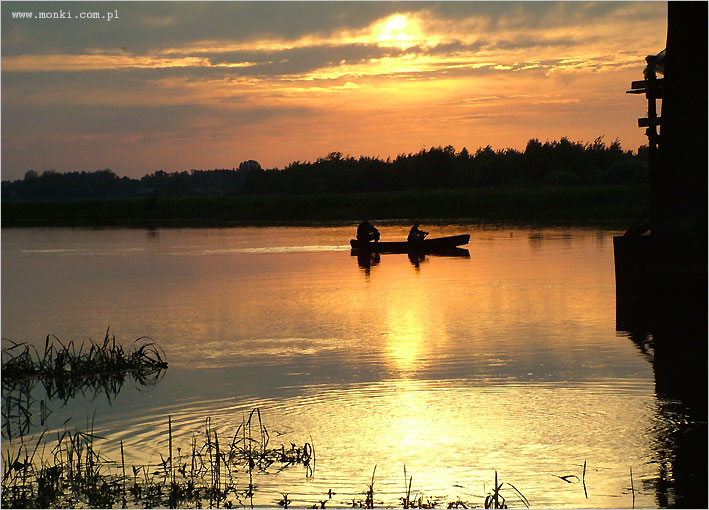
Today Goniądz has two thousand inhabitants. It is attractively located at the Biebrza river and near Biebrza National Park, hence a lot of tourists come here every year. There is a beach and a sport equipment hiring establishment as well as a hotel.
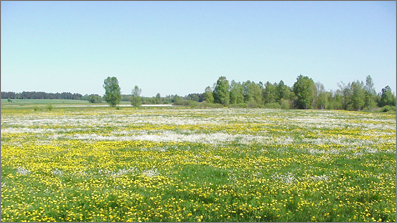
and St. Kazimierz (1920's) in Mońki,
The Town and Commune of Goniądz:
(beginning of 19th century) in Osowiec,
The Town and Commune of Knyszyn:
(from 1776) in Kalinówka Kościelna,
and St. John the Evangelist (from 16th) century in Knyszyn,
Commune of Krypno:
(from 1881-1885) in Krypno,
Commune of Jasionówka:
(second half of 18th century) in Jasionówka.
Commune of Jaświły:
(1859-1869) in Brzozowa,
(1830 - 31) in Dzięciołowo,
(1789 - 1791) in Dolistowo Stare.
Commune of Trzcianne:
(from 18th century) in Giełczyn,
(mid 19th century) in Trzcianne.

POWIAT MONIECKI
- kraina największych w Europie Środkowej bagien, lasu, czystego powietrza i unikatowej przyrody. Zamieszkują go gospodarni i życzliwi ludzie, Ziemia Moniecka oczekuje zatem na wszystkich, Powiat Moniecki...
Powiat Moniecki, w skład którego wchodzą miasta Gminy wchodzące w skład powiatu tworzą zwarty obszar. Jego centrum stanowi gmina i miasto Mońki, "Ziemie między Narwią a Bugiem mało mają sobie równych w naszej ojczyźnie. Jest tu pięknie o każdej porze roku. Uczulone na uroki krajobrazów oko odnajdzie w nich rzeczy zachwycające nawet pośród jesiennych mgieł i zimowej ciszy, najpiękniej jednak jest wiosną. Nieregularny bieg rzek, płynących polodowcowymi, zabagnionymi dolinami, gruba pokrywa śniegu i lodu powodują, że okolice, gdzie Biebrza wpada do Narwi, zamieniają się Włodzimierz Puchalski (1909 - 1979) wybitny polski przyrodnik, artysta fotografik, prekursor polskiego Powiat trzech parków...
Powiat Moniecki stanowi obszar o wyjątkowych walorach ekologicznych i krajobrazowych. Biebrzański Park Narodowy - przyrodnicza perła Tak duży i unikatowy naturalny kompleks torfowisk położony nad malowniczo meandrującą rzeką posiada nadzwyczajne walory krajobrazowe, inspirujące Bagnom Biebrzańskim zawdzięczamy również odtworzenie w naszym kraju całkowicie wymarłych niegdyś bobrów. W 1949 roku 18 sztuk tego gatunku sprowadzono z Białorusi do kanałów okalających Twierdzę Osowiec. Tutejsze rzeki, rzeczki i kanały okazały się istnym rajem dla tych zwierząt.
Dziewiczość i niedostępność tych terenów sprawiły, Królewska Puszcza Knyszyńska...
Wielkie znaczenie ekologiczne i cenne walory krajobrazowe przyciągają również rzeszę turystów Nad Narwią...
Południowe krańce powiatu monieckiego należą do Obszaru Chronionego Krajobrazu "Doliny Narwi" Wielkim miłośnikiem nadbiebrzańskiej i nadnarwiańskiej przyrody był Włodzimierz Puchalski (1909 - 1979). We wstępie do swego albumu "Na rozlewiskach Biebrzy i Narwi" Włodzimierz Puchalski pisał: Spacerem po powiecie...
Mońki - położone w samym centrum powiatu - są jego stolicą i największym miastem. Ich historia wiąże się z wybudowaną pod koniec XIX wieku stacją kolejową, przy której powstała na początku niewielka osada. W ciągu zaledwie kilkudziesięciu lat z niewielkiej osady powstało szybko rozwijające się miasto z gmachami użyteczności publicznej, instytucjami kultury i oświaty. Dzisiejsze Mońki liczą 11 tysięcy mieszkańców Twierdza Osowiec...
Twierdza Osowiec to niewątpliwie najcenniejszy Od chwili wybudowania w 1892 roku Twierdza Osowiec miała ogromne znaczenie strategiczne, gdyż zamykała jedyną przeprawę przez rozległe bagna i rozlewiska biebrzańskie. Mimo, że posiadała tylko Znaczenie strategiczne Twierdzy dostrzeżono również Corocznie w Twierdzy organizowane są warsztaty malarskie. W 1998 roku na terenie Fortu I otwarto muzeum Twierdzy Osowiec. Przy jednostce działa Osowieckie Towarzystwo Fortyfikacyjne, którego członkowie chętnie oprowadzą po Twierdzy, jej mrocznych i tajemniczych schronach, poternach, podziemiach, a także "tunelu śmierci", Twierdza Osowiec to miejsce atrakcyjne nie tylko dla turystów. Od lat zadomowiły się tu liczne gatunki zwierząt, m.in. orzeł bielik, łosie i sarny, w fosach spotkać można też ryby, bobry, zaskrońce... Krypno - duchowa stolica regionu...
Położone w odległości 22 km od Moniek Krypno od wieków stanowi słynny ośrodek pobożności maryjnej. Knyszyn - miasto Króla Zygmunta Augusta
W XVI wieku był miastem królewskim, ulubionym miejscem pobytu Zygmunta Augusta, który nie tylko uwielbiał polować w tutejszych puszczach, ale także władał stąd Rzeczypospolitą Obojga Narodów. Goniądz...
Już w średniowieczu powstała tu osada książąt mazowieckich. W 1547 roku Goniądz, stanowiący wówczas znaczący port rzeczny i ośrodek handlowy, uzyskał prawa miejskie. Znajdują się tu zachowane resztki XVI-wiecznego układu urbanistycznego oraz zabytkowy Kościół p.w. Św. Agnieszki z lat 20-tych Agroturystyka - tradycja i ekologia
Życie ludzi na terenie powiatu monieckiego od wieków wpisane było w rytm przyrody, a utrwalone naturalne sposoby uprawy roli nie naruszyły równowagi ekologicznej. To dzięki temu bezcenne obszary naturalne nie uległy zniszczeniu i dewastacji. Bogata przeszłość historyczna, wpływy kultury polskiej, litewskiej, ruskiej, pruskiej, jaćwingowskiej i żydowskiej, a także żarliwa religijność ukształtowały niezwykle barwne dziedzictwo kulturowe ziemi monieckiej. I choć rozwój cywilizacji doprowadził do istotnych zmian trybu życia jej mieszkańców, ciągle jeszcze żywe są ślady dawnej kultury, tradycji, a nawet sposobów gospodarowania. Dlatego też i dziś można spotkać rolników pozyskujących torf opałowy z biebrzańskich bagien, rybaków płynących tradycyjnymi łodziami czy posługujących się tradycyjnymi metodami kosiarzy traw. Wszystko to w połączeniu z tradycyjną gościnnością tutejszych mieszkańców sprawia, że dużym powodzeniem cieszą się gospodarstwa agroturystyczne, w których tanio i atrakcyjnie można spędzić czas.
Gospodarka...
Liczący około 45 tysięcy mieszkańców powiat moniecki to region o charakterze typowo rolniczym. Sprzyjające warunki klimatyczno-glebowe oraz nieskażone zanieczyszczeniami środowisko naturalne sprzyjają uprawom zbóż i ziemniaków, produkcji zwierzęcej - przede wszystkim hodowli bydła mlecznego i trzody chlewnej. Ponadto rozwija się tu drobny przemysł przetwórstwa rolnego. Zabytki powiatu monieckiego:
Miasto i Gmina Mońki:
Miasto i Gmina Knyszyn:
Gmina Jasionówka:
Gmina Jaświły:
Gmina Krypno:
Gmina Trzcianne:
kultywujący tradycje ludowe, regionalne zwyczaje,
a jednocześnie dbający o rozwój i nowoczesność.
Zakątek ten, zachwycając oryginalną formą
i niepowtarzalną strukturą, przyciągać może nie tylko biologów i badaczy, ale również turystów chcących nacieszyć oko żyjącym na wolności bobrem,
łosiem czy batalionem.
którzy szukają miejsc zacisznego wypoczynku
oraz szans na bezpieczne lokowanie i pomnażanie kapitału - poprzez realizację inicjatyw gospodarczych.
i gminy: Mońki, Goniądz, Knyszyn oraz gminy: Jasionówka, Jaświły, Krypno i Trzcianne, położony
jest u zbiegu Biebrzy i Narwi, w centralnej części województwa podlaskiego.
Obejmuje on obszar 138 259 ha (ok. 7% powierzchni województwa), z czego użytki rolne zajmują 79 526 ha, tereny leśne - 28 560 ha, zaś wody - 2 139 ha.
Mieszka tu 45 831 osób, co stanowi 4% ludności województwa.
Teren powiatu odznacza się wieloma walorami przyrodniczymi, krajobrazowymi i historycznymi
oraz posiada ogromne możliwości rozwoju rolnictwa
i turystyki.
Oferuje wypoczynek w naturalnym środowisku,
w kontakcie z przyrodą, m.in. w gospodarstwach agroturystycznych, zaprasza do zwiedzenia ciekawych zabytków oraz zachęca do wykorzystania istniejącego
tu potencjału gospodarczego.
w którym mieści się siedziba Starostwa Powiatowego. Centralne położenie Moniek z szybkim i dogodnym dojazdem dla ludności pozostałych gmin oraz zlokalizowane w nich inne instytucje
znakomicie ułatwiają obsługę obywateli.
w ogromne rozlewiska.(...)"
filmu przyrodniczego.
Ze wszech stron otaczają go cenne obiekty przyrodnicze: od zachodu pokaźne połacie powiatu obejmuje Biebrzański Park Narodowy, ze strony wschodniej
w granicach powiatu leżą obrzeża Parku Krajobrazowego Puszczy Knyszyńskiej, krańce południowe stanowią natomiast fragment Obszaru Chronionego Krajobrazu "Doliny Narwi"
i stykają się z otuliną Narwiańskiego Parku Narodowego.
Europy Najcenniejszym obiektem przyrodniczym powiatu jest unikatowy na skalę europejską
Biebrzański Park Narodowy.
Stanowi on jedyny w tej części kontynentu naturalny obszar bagienny. To, że udało się go zachować w niezmienionym stanie, zawdzięczamy wieloletnim staraniom przyrodników i ekologów, które doprowadziły do zaniechania niszczących działań melioracyjnych. Ukoronowaniem było utworzenie w tym miejscu na początku parku krajobrazowego, a następnie w 1993 roku - największego w Polsce parku narodowego.
nie tylko artystów, fotografików, malarzy,
ale również spragnionych wrażeń turystów.
Stanowi on ostoję wielu rzadkich gatunków fauny i flory. Od wieków zamieszkują tu wydry, borsuki, lisy, jenoty, wilki, łasice, gronostaje... Bagna Biebrzańskie to przede wszystkim jednak królestwo ptaków: żyje ich tu przeszło 200 gatunków. Najrzadsze z nich to orzeł bielik, orlik grubodzioby, bocian czarny, wodniczka oraz
- stanowiący symbol Biebrzańskiego Parku Narodowego
- batalion.
W korycie meandrującej Biebrzy, jej dopływach oraz starorzeczach żyje także kilkadziesiąt gatunków ryb i innych zwierząt wodnych.
O walorach tych terenów decyduje również bogactwo flory. To właśnie nad Biebrzą można wciąż spotkać rzadkie i ginące gatunki roślin, np. brzozę niską, wierzbę lapońską, wierzbę borówkolistną, skalnicę torfowiskową czy gnidosza królewskiego.
Bagnom Biebrzańskim zawdzięczamy też ocalenie wielu gatunków roślin
i zwierząt.
Już na początku dwudziestego stulecia utworzono tu dwa ścisłe rezerwaty przyrody: Czerwone Bagno i Grzędy. Kiedy w okresie II wojny światowej niemal całkowicie wytępiono w Polsce populację łosia, to jedynie tylko na terenie Czerwonego Bagna przetrwało kilka osobników tego gatunku. Dały one początek odrodzeniu się tych zwierząt. W latach powojennych potomkowie biebrzańskich łosi przewędrowały do odległych obszarów Polski, a także za jej granice.
Dziś, przy odrobinie szczęścia i cierpliwości, turysta czy przyrodnik bez trudu spotka żyjącego nad Biebrzą łosia.
że Bagna Biebrzańskie były przez lata obiektem zainteresowania głównie naukowców i koneserów.
Udało się przez to uniknąć niszczącej dla środowiska, hałaśliwej turystyki masowej.
Obecnie - dzięki powstaniu Biebrzańskiego Parku Narodowego oraz rozwojowi odpowiedniej infrastruktury - miejsce to stało się bardziej przyjazne także dla turysty-amatora. Dziś, aby doświadczyć obcowania z unikatową przyrodą biebrzańską, nie koniecznie trzeba w gumowych butach przemierzać niebezpieczne bagna i bezkresne rozlewiska wodne. Specjalnie wytyczona ścieżka przyrodniczo-historyczna, zaopatrzona w kładki spacerowe, wieże widokowe i pomosty, umożliwia przejście suchą stopą interesujących fragmentów parku, a w mieszczącym się Osowcu - Twierdzy terenowym ośrodku edukacyjnym można skorzystać z wiedzy specjalistów oraz usług licencjonowanych przewodników.
i naukowców do Parku Krajobrazowego Puszczy Knyszyńskiej im. prof. Witolda Sławińskiego.
Został on utworzony w 1988 roku celem ochrony naturalnych zespołów leśnych, dolin rzecznych i źródlisk w niezmienionych przez cywilizację formach.
Już od wieków słynęły one jako kraina zamieszkiwana przez dzikie zwierzęta, na które między innymi polował król Zygmunt August.
Dziś, podobnie jak w czasach królewskich, na terenie parku spotkać można jelenie, łosie, sarny, dziki, a od 1975 roku - sprowadzone z Białowieży - żubry. Puszcza Knyszyńska to także ostoja 139 gatunków ptaków lęgowych, m.in. bociana czarnego, dzięcioła trójpalczastego i żurawia. Znajdują się tu też liczne pomniki przyrody - sędziwe drzewa i głazy narzutowe.
Charakterystycznym elementem puszczy są również drewniane kapliczki wiszące na tzw. "świętych sosnach". Ich tradycja wywodzi się z czasów powstania styczniowego, w czasie którego stanowiły one skrzynki kontaktowe powstańców.
Wart polecenia jest także leżący na obrzeżach puszczy rezerwat przyrody "Wielki Las", utworzony ze względu na wybitne walory przyrodnicze.
i nieomal stykają się z otuliną Narwiańskiego Parku Narodowego. Ten jeden z najmłodszych parków narodowych w Polsce został utworzony w 1996 roku celem zachowania w naturalnym stanie ostatniego nieprzetworzonego fragmentu doliny Narwi - z jego bogactwem fauny, flory oraz walorami krajobrazowymi.
Ten wybitny polski artysta - fotografik, pionier polskiego filmu przyrodniczego - w 1948 roku "odkrył" położoną nad Narwią wieś Morusy (gm. Krypno).
Odtąd, zachwycony urokiem tutejszej ziemi, odwiedzał
ją każdego roku. Wkrótce kupił XVIII-wieczną, krytą strzechą chatę. Stałą się ona, jak sam to określał, bazą wypadową jego "bezkrwawych łowów", podczas których myśliwską broń zastępowały aparat fotograficzny lub kamera. Po jego nagłej śmierci podczas wyprawy badawczej na Antarktydę, jego pełna pamiątek
i sprzętów chata w Morusach została objęta opieką i do dziś, zachowując niezwykły klimat sprzed lat,
funkcjonuje jako prywatne mini muzeum poświęcone swemu dawnemu właścicielowi.
"Krajobraz zmienia się tu z dnia na dzień i tam, gdzie jeszcze wczoraj lśniła błękitno-seledynowa powierzchnia bezkresnych wód, dziś zielenieją łąki, które niebawem eksplodują złotem kwitnących kaczeńców."
W latach dwudziestych XX wieku wybudowano duży, neobarokowy Kościół p.w. M. B. Częstochowskiej
i Św. Kazimierza zaprojektowany przez znanego warszawskiego architekta - Stefana Szyllera.
Przełomem w rozwoju Moniek stało się utworzenie tu siedziby władz powiatowych (1954) i nadanie praw miejskich (1965).
i stanowią ważny ośrodek gospodarczy, usługowy
i kulturalny. Dzięki rozwiniętej infrastrukturze miejskiej oraz posiadanemu zapleczu turystycznemu miasto
stanowi dogodną bazę wypadową dla tych,
którzy chcą się zapoznać z niepowtarzalnymi walorami przyrodniczymi oraz bogatą historią wsi i miasteczek powiatu monieckiego.
zabytek powiatu monieckiego. Znajduje się ona na terenie Biebrzańskiego Parku Narodowego, co tym bardziej zachęca do zwiedzenia tego unikatowego przykładu carskiej architektury obronnej.
Większość obiektów znajduje się na obszarze jednostki wojskowej, której władze udostępniły ją do zwiedzania.
cztery forty, stanowiła jedną z najsilniejszych twierdz,
a zawdzięczała to dobrze rozwiniętemu systemowi przedpól i śluz.
W czasie I wojny światowej trzykrotne próby jej zdobycia przez wojska niemieckie nie powiodły się: rosyjską załogę ewakuowano stąd dopiero w sierpniu 1915 roku w związku z ogólnie niekorzystną sytuacją
na całym froncie.
W okresie międzywojennym mieściła się tu m.in. Centralna Szkoła Podoficerów Korpusu Ochrony Pogranicza, dwa szwadrony 9 Pułku Strzelców
Konnych im. Gen. Pułaskiego oraz dywizjon artylerii
KOP "Osowiec".
w czasie II wojny światowej, kiedy to zarówno wojska sowieckie, jak i niemieckie, oparły swą obronę w tym rejonie właśnie na bagnach biebrzańskich.
w którym pokutuje duch carskiego oficera.
Przewodnicy opowiedzą też o historii obiektu i związanych z nim legendach, zjawach oraz duchach.
W obiektach fortyfikacyjnych znajduje się również jedno z największych zimowisk nietoperzy w Polsce.
W Kościele p.w. Narodzenia Najświętszej Maryi Panny z II połowy XIX wieku znajduje się słynący łaskami namalowany na lipowej desce wizerunek Matki Boskiej Pocieszenia, którego kult sięga XVI wieku. Jest to jedna z najwcześniejszych kopii obrazu Matki Bożej Śnieżnej
z Bazyliki Santa Maria Maggiore w Rzymie, sprowadzona prawdopodobnie przez hetmana Jana Zamoyskiego do swojej kaplicy w pobliskim Knyszynie. W 1985 roku odbyła się uroczysta koronacja obrazu diademami papieskimi, co przyczyniło się do dalszej popularyzacji sanktuarium, będącego tradycyjnym miejscem pielgrzymek mężczyzn, rodzin i młodzieży
z terenu całej archidiecezji.
To właśnie w Knyszynie ten ostatni władca z dynastii Jagiellonów zmarł 7 lipca 1572 roku.
"Czasy Zygmuntowskie" stanowiły złoty wiek Knyszyna, który w 1568 roku otrzymał prawa miejskie. Wybudowano wówczas ratusz, łaźnie, budynek wagi, wybrukowano ulice.
Świadectwem dawnej świetności są zachowane do dziś fragmenty XVI-wiecznego układu urbanistycznego oraz późnogotycki Kościół p.w. Św. Jana Apostoła i Ewangelisty. O wielokulturowej przeszłości miasta przypominają zabytkowe cmentarze: katolicki, protestancki, prawosławny i żydowski.
Obecnie w Knyszynie mieszka około 3 tysiące osób. Mieszczą się tu szkoły, placówki ochrony zdrowia, a także ośrodek kultury, wokół którego skupia się życie kulturalne, z działającymi zespołami muzycznymi, plastycznymi oraz teatrem amatorskim.
XX wieku.
Dziś Goniądz liczy około 2 tysięcy mieszkańców, jest siedzibą władz gminnych, szkół oraz ważnym ośrodkiem handlu i usług. Atrakcyjne położenie nad rzeką Biebrzą oraz bliskość Biebrzańskiego Parku Narodowego przyciągają corocznie wielu turystów.
Na miejscu znajduje się plaża z wypożyczalnią sprzętu sportowego, hotele i pensjonaty.
Na terenie powiatu znajdują się trzy ośrodki miejskie,
z których największe są - liczące 11 tysięcy mieszkańców - Mońki, położone przy dwóch ważnych trasach komunikacyjnych województwa podlaskiego:
linii kolejowej Białystok-Ełk oraz drogi krajowej nr 65. Miasto ma dogodne połączenie z miastami takimi, jak Białystok (44 km), Grajewo (36 km) i Ełk (56 km),
w stosunku do których położone jest centralnie.
Także 3-tysięczny Knyszyn i 2-tysięczny Goniądz mają dogodne połączenia komunikacyjne. Wszystko to zapewnia dobre warunki transportu surowców i produktów pomiędzy powiatem monieckim a regionem oraz otwiera możliwości współpracy z pobliskimi
rynkami wschodnimi.
Podjęciu działalności sprzyja również dobrze rozwinięta infrastruktura techniczna (poszczególne gminy mają nowoczesne centrale telefoniczne, oczyszczalnie ścieków itd.). Funkcjonuje też rozwinięte zaplecze biznesowe (m. in.: liczne podmioty gospodarcze, Centrum Wspierania Biznesu, banki, urząd skarbowy itp.).
W gminach Jaświły i Jasionówka działają Zrzeszenia Producentów Rolnych, zaś w Mońkach - Zespół Doradztwa Rolniczego.
Dodatkowym atutem powiatu monieckiego jest bliskość Białegostoku, w którym zlokalizowane są urzędy rządowej i samorządowej administracji wojewódzkiej,
a także Giełda Rolno-Spożywcza.
w Osowcu,
w Jasionówce.
w Brzozowej,
w Dzięciołowie,
w Dolistowie Starym.
w Krypnie (Sanktuarium Maryjne),
w Morusach.
w Giełczynie,
w Trzciannem.
